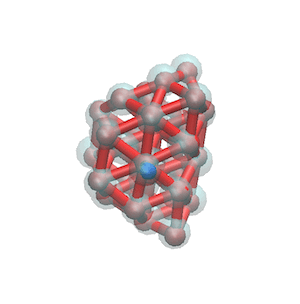Atomistic-scale simulations of realistic, complex, reactive materials: the ReaxFF reactive force field and its industrial and academic applications
Presented by Professor Adri van Duin from RxFF Consulting and Pennsylvania State University
The ReaxFF method provides a highly transferable simulation method for atomistic scale simulations on chemical reactions at the nanosecond and nanometer scale. It combines concepts of bond-order based potentials with a polarizable charge distribution.
Since its initial development for hydrocarbons in 2001 [1], we have found that this concept is transferable to applications to elements all across the periodic table, including all first row elements, metals, ceramics and ionic materials [2]. For all these elements and associated materials we have demonstrated that ReaxFF can accurately reproduce quantum mechanics-based structures, reaction energies and reaction barriers, enabling the method to predict reaction kinetics in complicated, multi-material environments at a relatively modest computational expense. At this moment, over 1000 publications including ReaxFF development of applications have appeared in open literature and the ReaxFF code – as implemented in LAMMPS, ADF, or in standalone-format – has been distributed around the world.
This presentation will describe the current concepts of the ReaxFF method, the current status of the various ReaxFF codes, including parallel implementations and acceleration methods. Also, we will present and overview of recent and past applications to complex materials, including the synthesis of carbon fibers [3] and carbon nanotubes [4], applications to perovskite based ferroelectric materials[5], cold sintering of complex oxides [7] and recent developments for expansion of ReaxFF for events that require explicit electrons (e-ReaxFF) [7].
sessionid hidden
References
[1] van Duin, A. C. T., Dasgupta, S., Lorant, F., and Goddard, W. A., 2001. ReaxFF: A reactive force field for hydrocarbons. Journal of Physical Chemistry A 105, 9396-9409.
[2] Senftle, T., Hong, S., Islam, M., Kylasa, S.B., Zheng, Y., Shin, Y.K., Junkermeier, C., Engel-Herbert, R., Janik, M., Aktulga, H.M., Verstraelen, T., Grama, A.Y. and van Duin, A.C.T. (2016) The ReaxFF Reactive Force-field: Development, Applications, and Future Directions. Nature Computational Materials 2, 15011.
[3] Mao, Q., Rajabpour, S., Kowalik, M. and van Duin, A.C.T. (2020) Predicting cost-effective carbon fiber precursors: Unraveling the functionalities of oxygen and nitrogen-containing groups during carbonization from ReaxFF simulations. Carbon 159, 25-36.
[4] Neyts, E.C., van Duin, A.C.T. and Bogaerts, A. (2011) Changing Chirality during SWNT Growth: a Reactive Molecular Dynamics Study. Journal of the American Chemical Society 133, 17225-17231.
[5] Akbarian, D., Nayir, N. and van Duin, A.C.T. (2021) Understanding the physical chemistry properties of BaxSr1-xTiO3 using ReaxFF based Molecular Dynamics Simulations. Physical Chemistry Chemical Physics 23, 25056-25062.
[6] Sengul, M.Y., Guo, J., Randall, C. and van Duin, A.C.T. (2019) Water-mediated surface diffusion mechanism of the Cold Sintering Process: A combined computational and experimental study. Angewandte Chemie International Edition 58, 12420-12424.
[7] Leven, I., Hao, H., Tan, S., Penrod, K.A., Akbarian, D., Hossain, M.J., Evangelisti, B., Islam, M., Koski, J., Moore, S., Aktulga, H.M., van Duin, A.C.T. and Head-Gordon, T. (2021) Recent Advances for Improving the Accuracy, Transferability and E_fficiency of Reactive Force Fields. Journal of Chemical Theory and Computation 17, 3237-3251.

